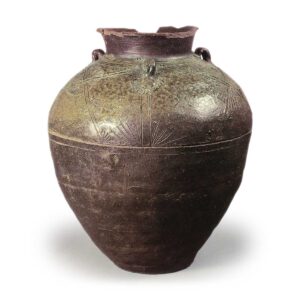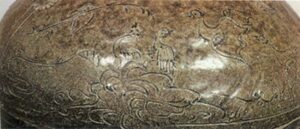

12th century
Height 39.3cm, Mouth diameter 16.5cm, Body diameter 34.0cm, Bottom diameter 13.5cm
Important Cultural Property
Aichi Prefectural Ceramic Museum
This large jar has a short, outer neck with a large bulging body and sloping shoulders. It has two clay cords attached to the shoulders on three sides, and the top and bottom of each ear are decorated with chrysanthemums, showing careful workmanship. As with the jar with the design of autumn grasses, it is made of a coarse grayish-yellow clay rich in sandy texture, and the pressure marks left on the exterior surface after the clay strings were rolled up by beating with a wooden mold remain intact. The firing is very good, and the dark-brown shoulder of the vessel is covered with a dark-green ash glaze.
The design is based on the ears and extends in three directions. First, the basic composition is the lotus petal design of the three-stripe pattern system. Two wide parallel sunken lines are drawn above and below the shoulders, dividing the whole into three sections. On two of the three sides, the parallel lines are tucked together, and at their intersections, petals are drawn radially in thick lines, creating a chrysanthemum-like pattern. In addition, a half-slice chrysanthemum design is painted between the base of the intersecting double lines and the chrysanthemum design. However, a closer look at the double chink lines shows that the upper line starts from the base of the ear, while the lower line does not reach the vertical line and is drawn down inward. Such a figure is common on many lotus petals produced by Atsumi kilns, and it is a case of omitting the drooping line on one side, which should be drawn with each ear at the top. The left side of the painting depicts two birds flying away from the surface of the water with their wings spread wide. The left side depicts two reeds extending supplely from the base of the vertical line toward the bird in the center. The four birds are thought to be herons because of the way they lean their heads in flight, but this is not certain. The artist’s skillful use of thick lines creates a flowing picture. This single painting depicts a waterside scene.



